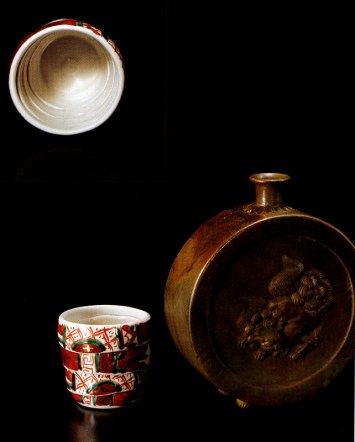|


Matsuda Yuriko and Bizen Tokkuri
Story by Robert Yellin
First Published Honoho Geijutsu #58, Spring 1999

Guinomi cup by Matsuda Yuriko
Tokkuri from late Edo early Meiji period
Why is it that some collectors of old ceramics don't want anything to do with contemporary ceramics, and why is it that the other way also holds true? I know some collectors who hardly touch anything not made before the Edo period and only buy pieces from the Meiji period and on with a condescending eye. And I know collectors of contemporary work that are afraid to buy antiques for various reasons. For example, they don't know that much about them and we all know there are some slimy antique dealers out there along with the honest ones; or maybe the pieces they want are too expensive; or perhaps they don't want to purchase something that needs their eye confirmed with knowledge. Sometimes that's hard to do with antiques.
Contemporary ceramics, on the other hand, are a safer purchase, as the maker is usually known, as well as the year it was made; that offers comfort to some collectors. Of course, there are many ways to look at collecting and since I happen to be alive at the present time I may as well seek out and support what's being made today. But I cannot neglect history, for the foundations of contemporary ceramics are discovered there.
So, I want to match the present (Matsuda Yuriko's guinomi) with a period of Bizen history that some often shun: Late Edo to Early Meiji. I was sitting and enjoying sake this past New Year's holiday with these two pieces and it made my heart smile -- one fairly old and the other new. How cool this tokkuri is and how joyous Matsuda's guinomi is! Bizen from the late Edo to early Meiji period, according to some, is a low point in Bizen history, but that's only if you compare it with some other period, like Momoyama. I truly love the Bizen saikumono (ornamental figures) that were made in the late-Edo-early-Meiji period -- the fat Hotei and the jovial Ebisu and Daikoku. This tokkuri is probably from the Tempo period (1830-1843) and has the most wonderful shishi (Chinese lion)on both sides. On the shoulder is a flash of hidasuki, not the best effect or firing that Bizen has to offer here then, but a representative piece from that time, and I dare say a very good one.
The guinomi, by veteran potter Matsuda Yuriko, reminds me of my grandmother. Americans love pies, apple, cherry, and blueberry among others. One of the secrets to a good pie is the crust and my grandmother made the absolute best crust and she used to top it off with strips that resemble the strips in Matsuda's lively cup. It's an American pie, it's an American quilt, it's a Chinese Wan-li gourd tokkuri, it's an Imari bowl, it's a Kutani plate; it's the history of Matsuda's ceramic journey in a small vessal.
The inside is pure white with ripples from where the porcelain strips overlap. The touch to the lip is cool. It's a very feminine cup in the way that it was formed and matches the masculine energy of the tokkuri. And lord knows this world needs more balance, between lifestyles and nature, and between men and women; I'm hoping the next century will see Japan's and America's first women leaders!
I'm sure that would make Matsuda happy and the shishi might even give her a little chuckle. I know I did after I discovered the splendid balance of the past and the present, of the man and the women, of the muted and the colorful in the matching of this shishi tokkuri and Matsuda Yuriko's patchwork cup: a match made in Yellin's heaven-kitchen.
LEARN MORE
|